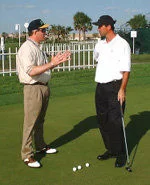
Why you Shouldn’t Play it Safe
How difficult is it for you to play with the lead as a round is coming to a close?
You would think it is easy having the lead but, for many golfers, there is an increased sense of pressure that comes with holding onto a lead.
Many golfers fear losing the lead or imploding during the round…
With one eye of the leader board, golfers playing with the lead can become more and more nervous as they see their lead shrink. When a golfer is in this type of position, they tend to play it overly safe which allows other golfers to climb back into contention.
This type of mindset is called the Play to NOT lose or Play It Safe mindset.
With this mindset, nerves, pressure and tension increase drastically making it more difficult than ever to just focus on playing your game.
The alternative to playing it safe is playing to win or focusing on success with each shot.
Playing to win requires that you overcome distractions, such as your overall score, the scores of other players, golfers that are surging up the leader board, your last bogey, the emotions you are experiencing, etc.
Playing to win is a matter of immersing yourself in the moment without over thinking or over analyzing your game.
When you play to win, you are still aware of your lead but you are not overly-focused on trying to maintain the lead.
Instead, when you play to win, you are trusting in your game fully and focused on the shot at hand.
Effectively managing the pressure of having the lead is what helped Brooks Koepka win the 2019 PGA Championship after entering the Final Round with a 7-stroke lead.
Despite a 7-stroke lead, Koepka only won by 2-strokes after shooting 4-over par on the final day of the tournament.
Koepka talked about the challenges that accompanied playing with the lead.
KOEPKA: “I think playing with the lead is a different feeling. It’s very difficult. You want to extend it. But also, you’re not trying to — you’re not trying to come back to the field, so every time you make a bogey, you’re kind of thinking, I’m bringing everybody back; I keep coming back, why am I doing this, what’s going on.”
Koepka set goals throughout the final round while having the lead in order to keep focused on playing to win.
KOEPKA: “I think playing with a lead is a little bit tougher [than playing from behind]. It’s easier in the sense of you know that you can afford mistakes, and you’ve just got to stay mentally sharp. I think you have to be sharper mentally when you have such a big lead that you still have to set goals. You still have to, okay, I still need to go out and go play.”
Playing with the lead may be challenging with pressure, but it if you focus on what truly matters, you can remain mentally sharp enough to finish out the round strong.
How to Focus when Playing with the Lead:
Avoid protecting your lead or slamming on the breaks to not make mistakes–this is playing to not lose. You have to keep the pedal to the medal.
Challenge yourself to go for your targets and set up birdie chances on the remaining holes.
Avoid focusing on outcomes and think about each hole as a new round, each shot at a new challenge.
Related Golf Psychology Articles
- Golfers Who Play to Not Lose Instead of Playing to Win
- How to Cope with Slow Play
- How to Play Good Golf Against Top Players
- Subscribe to The Golf Psychology Podcast on iTunes
- Subscribe to The Golf Psychology Podcast on Spotify
Golf Mental Coaching Programs

All golf psychology programs include the Golfer’s Mental Aptitude Assessment (GMAP), a custom Mental Game Plan, weekly coaching sessions, unlimited email correspondence, and The Golfer’s Mental Edge 2.0 workbook program.
One-on-one mental coaching is the fastest and most effective method to improve your mental game, boost your performance, and make lasting changes!
We have unique mental coaching programs, customized for you. Please contact us with any questions your have about our programs. Provide your name, email, and role below:
Or Call us today at 888-742-7225 | Mental Game Success Stories